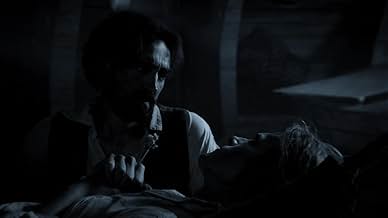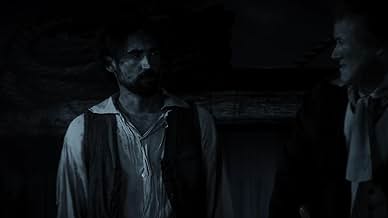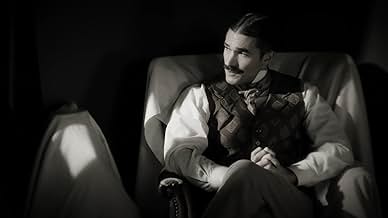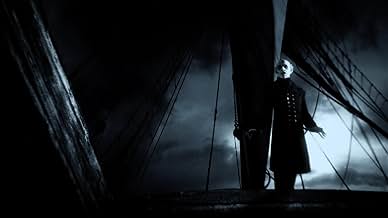Adicionar um enredo no seu idiomaVampire Count Orlok expresses interest in a new residence and real estate agent Hutter's wife.Vampire Count Orlok expresses interest in a new residence and real estate agent Hutter's wife.Vampire Count Orlok expresses interest in a new residence and real estate agent Hutter's wife.
- Direção
- Roteiristas
- Artistas
Eddie Allen
- Knock
- (as Edgar Allan Poe)
Avaliações em destaque
I've read a couple of bad reviews on this, and I feel like they don't get the aesthetics the director was going for. Everything in this screamed as an homage to the original, but with updated flair. Was the dialogue over the top, yes, but wasn't the dialogue cards in the original, also yes! The shots were highly stylized black and white and the use of red was well placed.
The original left us viewers with questions and surmising. This one takes a stronger stance and feels like it fills in the gaps and fleshes out these characters. It elevates it from the vaudeville feeling silent original to a more modern piece that highlights the original story.
It's definitely worth a watch. Just keep in mind that it is an aesthetic- much like Wes Anderson films; might not be for everyone, but dang it's a piece of art!
And besides everything, it's DOUG JONES! He's a legend and anything he is in, is worth a look-see. Trust me!
The original left us viewers with questions and surmising. This one takes a stronger stance and feels like it fills in the gaps and fleshes out these characters. It elevates it from the vaudeville feeling silent original to a more modern piece that highlights the original story.
It's definitely worth a watch. Just keep in mind that it is an aesthetic- much like Wes Anderson films; might not be for everyone, but dang it's a piece of art!
And besides everything, it's DOUG JONES! He's a legend and anything he is in, is worth a look-see. Trust me!
Doug Jones was great as usual, the movie however was a different story. The cinematics looked like something a couple of high school kids would have done on an iPhone 2. The director may have been trying to go for a specific "feel", but he failed miserably. It looked almost like an animated comic book. If that was the feel they wanted then they got it, but personally I did not like it at all. Most of the cast did an adequate job but they where wasted on this movie. I love Doug Jones and love vampire moves, but honestly just watch the original 1922 version or even the remake from 1979, both are far superior.
With the recent hype surrounding Robert Eggers' «Nosferatu», I was curious to see the remake of Friedrich Wilhelm Murnau's 1922 expressionist classic. This version was released in 2023, with the same original title, «Nosferatu: A Symphony of Horror», directed by David Lee Fisher, who had previously made a version of another expressionist classic, Robert Wiene's «The Cabinet of Dr. Caligari» (1920).
Fisher's film was shot in 2016, with most takes recorded against a green screen by cinematographer and visual effects specialist Christopher Duddy, and then images taken from the 1922 original were added and colorized. Post-production took seven years, until the finished work was released on November 11, 2023, to mixed reviews. Almost all critics praised Doug Fisher's performance as the vampire protagonist.
In truth, I was surprised to find that this movie, made and released without fanfare, is more effective in some ways than Eggers' proposal, who aspires to the title of new "master of horror cinema." To begin with, Fisher's film is more measured, restrained and direct (it lasts 92 minutes, that is, half an hour less than Eggers'), Jones' performance is indeed excellent and surpasses Bill Skarsgård's, and the story contains details that are more faithful to Bram Stoker than any other adaptation of his novel «Dracula.» For example, there is a moment in the novel where Stoker alludes to Dracula's terrifying gaze from a great distance. His gaze burns like two embers. Here, the woman victim and victimizer perceives the force of his eyes from her window to the ruined slaughterhouse that the vampire bought to live in, where he is watching her. And above all, it is a reserved film, without the gory effects of Eggers' film.
Both films suffer from the same thing: impertinent dialogue worthy of a soap opera (which Murnau was spared from, as he preferred silent films and narrating only with images and music). However, Fisher does stumble in the selection of the performers of the young real estate salesman and his wife (Jonathan and Lucy Harker in the novel and Werner Herzog's version; Thomas and Ellen Hutter in Henrik Galeen's script for Murnau's film, which inspired Eggers and Fisher). Emrhys Cooper has a bad start as the greedy young man that Fisher describes, playing Thomas Hutter as a frivolous guy, whose love for his wife Ellen is unconvincing. And Sarah Carter is a voluptuous blonde who conflicts with Stoker's idea of the pale, fragile and languid antiheroine (whose ideal interpreter to date has been Isabelle Adjani).
The visual work is plausible and it is surprising that not even the American Saturn Awards for horror and fantasy films have considered the film in their annual nominations and awards. Curiously, like Eggers' movie, Fisher's film does not inspire fear or shock. However, his respect for Murnau's work grants it a certain distinction and admiration that I find praiseworthy.
Fisher's film was shot in 2016, with most takes recorded against a green screen by cinematographer and visual effects specialist Christopher Duddy, and then images taken from the 1922 original were added and colorized. Post-production took seven years, until the finished work was released on November 11, 2023, to mixed reviews. Almost all critics praised Doug Fisher's performance as the vampire protagonist.
In truth, I was surprised to find that this movie, made and released without fanfare, is more effective in some ways than Eggers' proposal, who aspires to the title of new "master of horror cinema." To begin with, Fisher's film is more measured, restrained and direct (it lasts 92 minutes, that is, half an hour less than Eggers'), Jones' performance is indeed excellent and surpasses Bill Skarsgård's, and the story contains details that are more faithful to Bram Stoker than any other adaptation of his novel «Dracula.» For example, there is a moment in the novel where Stoker alludes to Dracula's terrifying gaze from a great distance. His gaze burns like two embers. Here, the woman victim and victimizer perceives the force of his eyes from her window to the ruined slaughterhouse that the vampire bought to live in, where he is watching her. And above all, it is a reserved film, without the gory effects of Eggers' film.
Both films suffer from the same thing: impertinent dialogue worthy of a soap opera (which Murnau was spared from, as he preferred silent films and narrating only with images and music). However, Fisher does stumble in the selection of the performers of the young real estate salesman and his wife (Jonathan and Lucy Harker in the novel and Werner Herzog's version; Thomas and Ellen Hutter in Henrik Galeen's script for Murnau's film, which inspired Eggers and Fisher). Emrhys Cooper has a bad start as the greedy young man that Fisher describes, playing Thomas Hutter as a frivolous guy, whose love for his wife Ellen is unconvincing. And Sarah Carter is a voluptuous blonde who conflicts with Stoker's idea of the pale, fragile and languid antiheroine (whose ideal interpreter to date has been Isabelle Adjani).
The visual work is plausible and it is surprising that not even the American Saturn Awards for horror and fantasy films have considered the film in their annual nominations and awards. Curiously, like Eggers' movie, Fisher's film does not inspire fear or shock. However, his respect for Murnau's work grants it a certain distinction and admiration that I find praiseworthy.
The whole point of this "remix film" was that it was supposed to utilize the old backdrops from the original 1922 feature, and green screen in new actors with actual dialogue.
However, director David Lee Fisher obviously changed his plan along the way, as what we get is instead a film where every backdrop seems to have been recreated with cgi (which explains why it took 10 years to complete).
And what you're left with is just a youtube-level fan production with embarrassingly bad actors lost in an uncanny valley. Even the ever lovable Doug Jones is like an intentional a parody of over acting, and the whole thing is just a sad imitation of the original.
However, director David Lee Fisher obviously changed his plan along the way, as what we get is instead a film where every backdrop seems to have been recreated with cgi (which explains why it took 10 years to complete).
And what you're left with is just a youtube-level fan production with embarrassingly bad actors lost in an uncanny valley. Even the ever lovable Doug Jones is like an intentional a parody of over acting, and the whole thing is just a sad imitation of the original.
Last night I had a serendipitous event: I viewed the David Lee Fisher version of Nosferatu, A Symphony of Horror. I haven't seen this movie, released in 2023 mentioned anywhere and imagined it has been overshadowed by this year's Bill Skarsgård/Nicholas Hoult production and thus had been largely ignored, though Amazon Prime Video and Tubi features it. It's been panned by some but I found it surprisingly well-done. Yes, it begins with some slightly stilted and occasionally bombastic scenery-chewing but settles in when one decides to watch it as if actually set in the period of the story. Then, both cast, dialogue and viewer adjust accordingly. The story blends scenes crafted to copy exactly some from the original 1922 Nosferatu, and occasional dialogue from Lugosi's version. There are some little jewels of cinematic moments, such as the backdrops appearing a combination of painting and projection giving it the primitive cinematic effect of the original. Stylish, artistic, surreal, and gothic, done in black and white. Except for the occasional bright red slash of blood or the golden lick of flames as when the Demeter burns.
As a whole, even with the "high school play" elements another viewer has panned, I much preferred this one over the 1979 Kinski Nosferatu which simply mirrored the original with dialogue and added nothing new (and believe me, at 82, I've seen a LOT of vampire/Dracula movies to compare it to). I thoroughly enjoyed it and look forward to the latest Nosferatu so I can add it to my very long list.
So...we all have our opinions and though my seem to swim against the majority...that's my opinion and I"m sticking to it.
As a whole, even with the "high school play" elements another viewer has panned, I much preferred this one over the 1979 Kinski Nosferatu which simply mirrored the original with dialogue and added nothing new (and believe me, at 82, I've seen a LOT of vampire/Dracula movies to compare it to). I thoroughly enjoyed it and look forward to the latest Nosferatu so I can add it to my very long list.
So...we all have our opinions and though my seem to swim against the majority...that's my opinion and I"m sticking to it.
Você sabia?
- CuriosidadesUses the character names from the original Nosferatu (1922), rather than the names from the novel "Dracula". The 1922 original was pulled from cinemas upon its release in 1923, after Bram Stoker's widow filed for copyright infringement. The first remake, Nosferatu: O Vampiro da Noite (1979), did use the character names from the novel, as the case was barred by the time of its production.
- ConexõesReferenced in WatchMojo: Top 10 Upcoming Horror Movie Remakes (2019)
Principais escolhas
Faça login para avaliar e ver a lista de recomendações personalizadas
- How long is Nosferatu?Fornecido pela Alexa
Detalhes
- Tempo de duração1 hora 32 minutos
- Cor
- Proporção
- 1.78 : 1
Contribua para esta página
Sugerir uma alteração ou adicionar conteúdo ausente

Principal brecha
What is the French language plot outline for Nosferatu: A Symphony of Horror (2023)?
Responda






























